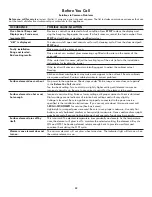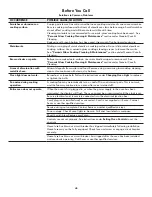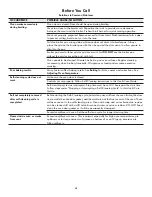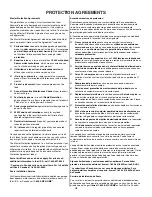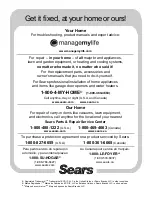
37
General Care & Cleaning
(cont’d)
Ceramic Glass Cooktop Cleaning & Maintenance
Consistent and proper cleaning is essential to maintaining your Ceramic glass cooktop
Prior to using your cooktop for the first time, apply the recommended CookTop® Cleaning Creme to the ceramic surface
(on the web visit
www.sears.com
for replacement cooktop cleaner, item number 40079). Buff with a
non-abrasive
cloth
or
no-scratch
cleaning pad. This will make cleaning easier when soiled from cooking. The special cooktop cleaning cream
leaves a protective finish on the glass to help prevent scratches and abrasions.
Sliding aluminum or copper clad bottom pans on the cooktop can cause metal mark-
ings on the cooktop surface. These marks should be removed
immediately
after the
cooktop has cooled using the cooktop cleaning cream. Metal marks can become
permanent if not removed prior to future use.
Cookware (cast iron, metal, ceramic or glass) with rough bottoms can mark or scratch
the cooktop surface.
Do not slide anything metal or glass
across the cooktop.
Do not
use your cooktop as a cutting board or work surface in the kitchen.
Do not
cook foods
directly on the cooktop surface without a pan.
Do not
drop heavy or hard objects on
the glass cooktop, because they may cause it to crack.
Cleaning Recommendations for the Ceramic Glass Cooktop
Before cleaning the cooktop, be sure the controls are turned to
OFF
and the cooktop is COOL.
DO NOT
use a cooktop cleaner on a hot cooktop. The fumes can be hazardous to your health, and can
chemically damage the ceramic glass surface.
For light to moderate soil:
Apply a few drops of CookTop® Cleaning Creme directly to the cooktop. Use a paper towel or use a
non-abrasive
plastic type
no-scratch
cleaning pad to clean the entire cooktop surface. Make sure the cooktop is cleaned thoroughly, leaving no residue.
For heavy, burned on soil:
Apply a few drops of CookTop® Cleaning Creme directly to the soiled area. Rub the soiled area using a
non-abrasive
plastic type
no-scratch
cleaning pad, applying pressure as needed. Do not use the pad you use to clean the cooktop for any
other purpose.
If soils remain, carefully scrape soils with a metal razor blade scraper, holding
scraper at a 30 degree angle to the surface. Remove loosened soils, then apply a
few drops of cleaning cream and buff surface clean.
IMPORTANT NOTE:
Damage to the ceramic glass cooktop may occur if you use
an abrasive cleaning pad. Only use cleaning products that have been specifically
designed for ceramic glass cooktop.
Plastic or foods with a high sugar content:
These types of soils need be removed immediately if spilled or melted onto the
ceramic cooktop surface. Permanent damage (such as pitting of the cooktop
surface) may occur if not removed
immediately
. After turning the surface elements
OFF, use a razor blade scraper or a metal spatula with a mitt and scrape the soil from the hot surface (as illustrated). Allow
the cooktop to cool, and use the same method for heavy or burned on soils.
Do not use the following on the ceramic glass cooktop:
• Do not use abrasive cleaners and scouring pads, such as metal and some nylon
pads. They may scratch the cooktop, making it more difficult to clean.
• Do not use harsh cleaners, such as chlorine bleach, ammonia or oven cleaners, as
they may etch or discolor the cooktop.
• Do not use dirty sponges, cloths or paper towels, as they can leave soil or lint on
the cooktop which can burn and cause discoloration.
Special Caution for Aluminum Foil and Aluminum Cooking Utensils
• Aluminum foil:
Use of aluminum foil will damage the cooktop. Do not use under
any circumstances.
• Aluminum utensils:
Since the melting point of aluminum is much lower than that of
other metals, care must be taken when aluminum pots or pans are used. Pans that boil
dry may permanently damage cooktop by breaking, fusing to, or marking it.
Summary of Contents for Elite 790.9751 Series
Page 42: ...42 Notes ...

















